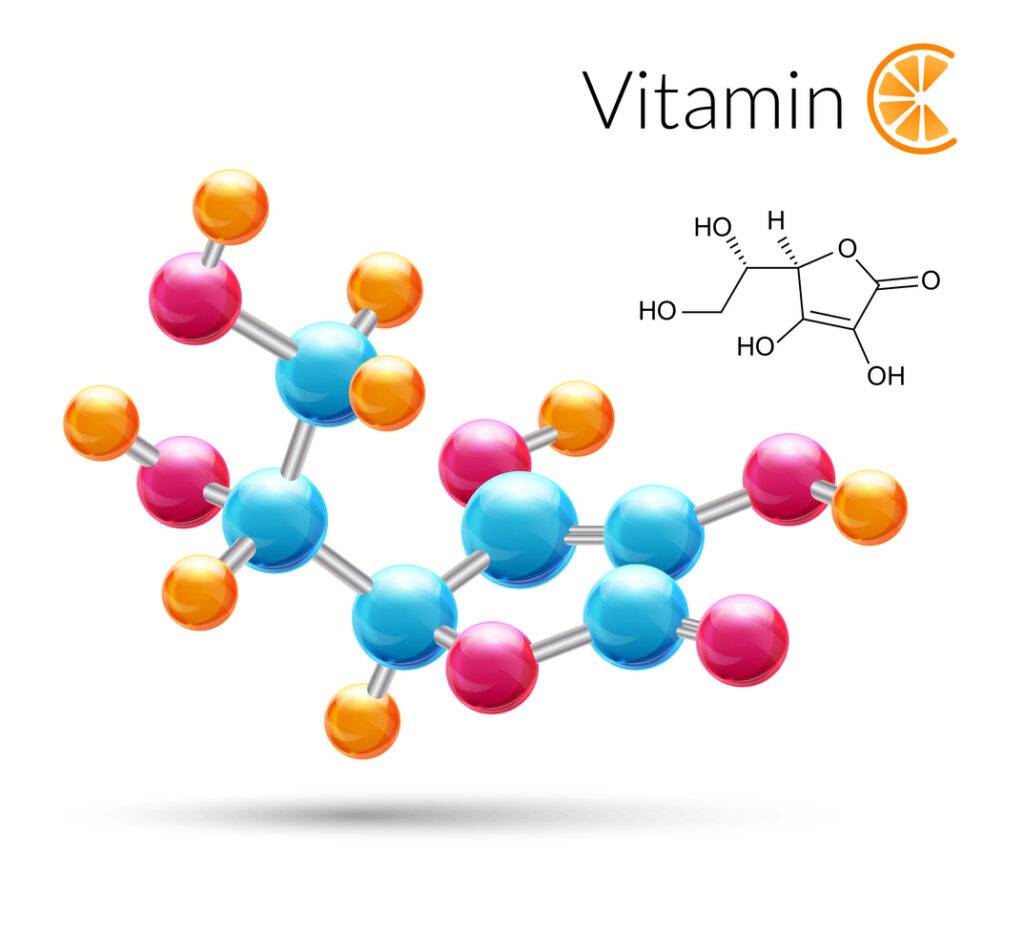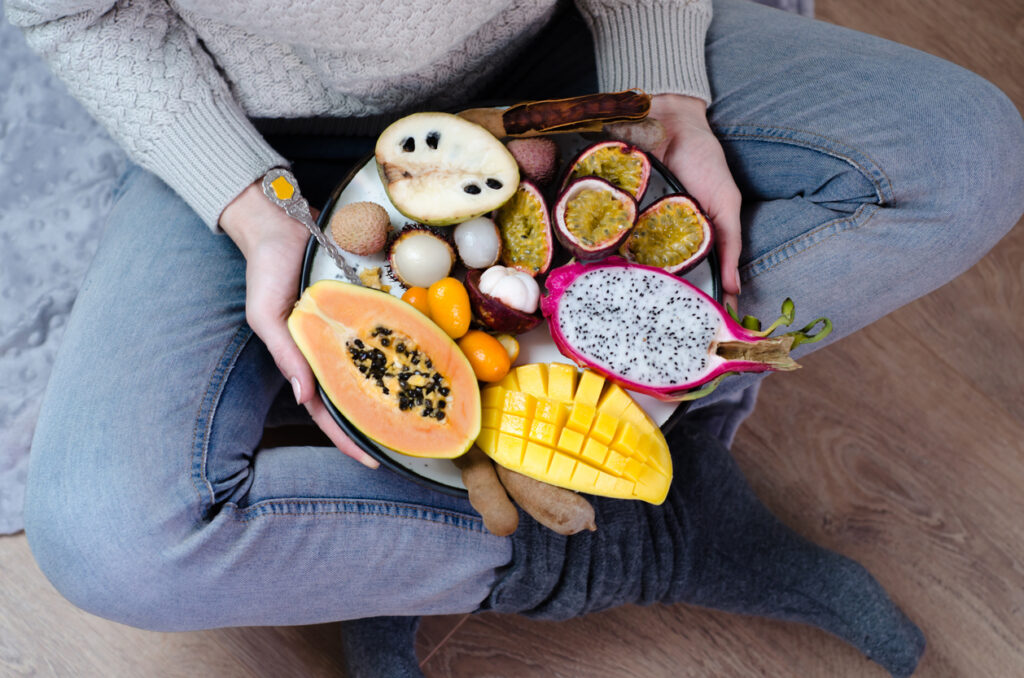Did humans evolve to eat mainly fruits? Our anatomy is very similar to other frugivorous apes, and thus, it is an important question whether we naturally have a frugivorous diet, too. And to no surprise – but major fascination – there is a gene that deserves more attention and investigation as a possible proof of optimal human health still being hooked on a diet high in fruits! Our “lost” vitamin C genes could just turn out to be “The Frugivore Gene” and bring us closer to answering: Are humans actually frugivores?
GULO gene: Vitamin C in animals
Vitamin C is a potent antioxidant and is needed in many biochemical reactions in the body of animals and plants alike. It plays a vital role in living organisms. We know that humans need to get vitamin C from diet! We usually associate vitamin C with diet, especially plant foods like citrus fruits. Plants are known to synthesize vitamin C, but what is less commonly known is that there is the biosynthesis of vitamin C in animals, too! In fact, most animal species have functional vitamin C genes. A few examples are dogs, cows, most birds and reptiles, and even mollusks.
Animals and plants produce vitamin C. Animals produce vitamin C from glucose in the liver. And while there are different pathways of vitamin C synthesis, the outcome is the same molecule.

The GULO gene is a part of the vitamin C genes in animals. It codes for the L-gulonolactone oxidase – an enzyme that converts the precursor of vitamin C ( L-gulonolactone) into the final active vitamin C (L-ascorbic acid). The enzyme is the last one in a sequence of enzymes needed to produce vitamin C. In humans, the gene sequence lacks multiple exons (coding regions of the DNA).
The GULO gene is essential for life!
The GULO gene has been kept throughout evolution by most animal species, indicating its essential, vital function for life! The loss of the GULO enzyme in humans means our vitamin C production is broken! But why? And how can we even survive without it?
In fact, the loss of functional vitamin C genes have baffled scientist as “neither animals nor plants can live without vitamin C, and it is therefore surprising that some animals have lost the capability to produce it over the course of evolution.” (de Tullio, 2010). The types of genes that are essential for life do not change much during evolutionary history and are, thus, “conserved” genes. The vitamin C genes are highly conserved in the Tree of Life. Such basic, essential genes are also called housekeeping genes.
“Housekeeping genes are examples of regions in a genome that tend to be highly conserved and evolve slower than other genes such as the tissue-specific genes mainly due to their roles in the maintenance of basic cellular functions and are essential for the existence of a cell.”
Ong, 2019
So what is going on here? Why does such an ancient gene mutate and become a pseudogene in humans? Why is the GULO gene conserved in most animals but “broken” in humans and apes, making them auxotrophs for vitamin C? The answer lies in a fruit-rich diet:
Is the GULO Pseudogene the “Frugivore Gene”?
Is broken Vitamin C genes – or GULO Pseudogenes – a possible genetic marker to identify fruit-eating animal species? The GULO Pseudogene looks like an interesting candidate as a “frugivore gene” it is typical for (and possibly unique to) animal species with high-fruit diets (see below). Moreover, it is self-explanatory that only species with a high vitamin C diet lack the internal production of vitamin C! But let’s elaborate:
Who has broken vitamin C genes – and why?
While humans still carry the GULO gene, it has mutated to the extent that it has become a dysfunctional pseudogene, now called GULOP or GULO Pseudogene. This means, at one point, our ancestors still carried the functional gene and vitamin C pathway before it mutated into being dysfunctional.
Alongside humans, there are a few other animal species that lack functional vitamin C genes: All apes, most primates, some bats, guinea pigs, some bird species, and some invertebrates do not produce vitamin C. By comparing the diet of those species we find a pattern and possibly even a straight-forward answer:
Animals with high-fruit diets don’t produce vitamin C
What have animals that depend on external vitamin C sources (food) in common? A comparison of diets reveals that animals with a GULO gene mutation have one thing in common: Vitamin C-rich diets, meaning high in fruits. They are all frugivores!

Figure: Vitamin C gene (GULO gene) loss has occurred independently in species with a frugivorous diet (with a high vitamin C intake). This phylogenetic tree by Drouin et al. (2011) illustrates the ability of different mammals to produce vitamin C. Dark green species have functional genes; light green species do not. Screenshot from Scientific American, showing that Lemurs (a primate with functional vitamin C genes) consume far less fruit than other primates”.
The GULO gene mutation seems unique to frugivores – across the animal kingdom! The GULO Pseudogene is thus a very strong indication that the natural human diet is still very high in fruits – tropical fruits in particular. Only a diet high in fruits gives us enough vitamin C – which is around 30 mg per kg body weight, which is the typical amount that mammals have (read more here).
Why is the GULOP a possible proof of frugivory? Because the natural selection of having internal vitamin C production when the populations/species consumed a diet low in fruit seems to have been strong enough to make them re-appear:
In some bird lineages, vitamin C production was lost but then re-emerged again due to a drop in the fruit content of their diet. This pattern is visible in the phylogenetic trees. This means losing vitamin C genes is only possible when the species has a fruit-rich diet. Otherwise, natural selection seems to be strong enough to drive the functional genes into existence again. And while this is not proof per se, it should be interesting enough to do further research into this topic!
Why not just keep the vitamin C genes anyway? Organisms can actually benefit from ceasing to produce vitamin C because producing it internally is energetically costly. In a sense, the frugivores outsource the metabolic task to the plants they consume – and save energy. Find more about this apparent evolutionary paradox of broken vitamin C genes in frugivores here.
Is the need to get Vitamin C the reason why humans go crazy for sweet-sour foods?
Acidic taste is off-putting for most animals – but not for frugivorous humans, apes, and birds! Just like sweet taste, humans enjoy sour taste, especially sweet sour. In contrast, most animals reject sour foods! We share our preference for slightly sour with all apes and the frugivorous monkeys and birds. Once more, this is a typical feature for frugivorous species, as most fruits have some acidic, sour flavor to them. (This phylogenetic tree by Frank et al. (2022) shows acid detection and preference in different animal species.)
Being attracted to acidic foods could be linked to the vital necessity to get vitamin C (ascorbic acid) via the diet: sour is a good indication of vitamin C in the food. Thus, vitamin C detection and attraction could be vital and adaptive in species without functional vitamin C genes.

What does GULOP mean for our diet?
The broken GULO gene carries a message: We should not underestimate the role of fruit-rich diets for humans!
Having broken vitamin C genes (GULO Gene) is unique to frugivores! What this means, as a logical follow-up, is that humans are supposed to be highly frugivorous, and, yes, our adaptations show that we are supposed to have a high-fruit diet naturally!

Knowing that our ancestors and closest relatives consume(d) that much vitamin C (fruits) that it led to the loss of our own vitamin C production takes the understanding of the importance of vitamin C-rich to another level:
We need much more fruits in our diet than we currently believe! This is one crucial lesson that our broken GULO gene might teach us! How much vitamin C do we actually need on a daily basis? If we learn from how much vitamin C animals get that produce it internally, we need a whooping amount of 2000-3000 mg! This is much more than humans obtain from an average diet but falls in line with what frugivores get via diet in nature. Read our full article on how much vitamin C we actually need.
Last updated on:
References
- Gulop Gulonolactone (L-) oxidase, pseudogene [homo sapiens (human)] – gene – NCBI (no date) National Center for Biotechnology Information. Available at: https://www.ncbi.nlm.nih.gov/gene/2989 (Accessed: 25 July 2023).
- Yang, H. (2013) ‘Conserved or lost: Molecular evolution of the key gene gulo in vertebrate vitamin C biosynthesis’, Biochemical Genetics, 51(5–6), pp. 413–425. doi:10.1007/s10528-013-9574-0.
- M.C De Tullio, The Mystery of Vitamin C. Nature news (available at https://www.nature.com/scitable/topicpage/the-mystery-of-vitamin-c-14167861/).
- Henriques, S.F. et al. (2019) ‘Multiple independent L-gulonolactone oxidase (GULO) gene losses and vitamin C synthesis reacquisition events in non-deuterostomian animal species’, BMC Evolutionary Biology, 19(1). doi:10.1186/s12862-019-1454-8.
- G. Drouin, J.-R. Godin, B. Page, The genetics of vitamin C loss in vertebrates. Current Genomics. 12, 371–378 (2011), doi:10.2174/138920211796429736.
- J. G. Goldman, Why lemurs have such strange diets. Scientific American (2018) (available at https://www.scientificamerican.com/article/why-lemurs-have-such-strange-diets/).
- Joshi, C.J. et al. (2022) ‘What are housekeeping genes?’, PLOS Computational Biology, 18(7). doi:10.1371/journal.pcbi.1010295.
- Ong, H.S. (2019a) ‘Comparative genomics analysis’, Encyclopedia of Bioinformatics and Computational Biology, pp. 425–431. doi:10.1016/b978-0-12-809633-8.20126-x.
- Frank, H.E. et al. (2022) “The evolution of sour taste,” Proceedings of the Royal Society B: Biological Sciences, 289(1968). Available at: https://doi.org/10.1098/rspb.2021.1918.


Add Comment